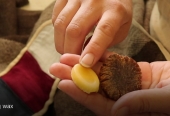posted 11 years ago
It is over a year later, but I will chime in on this thread. I chose TBH because I wanted the bees to have the experience that I consider most bee like. When it comes to TBH, you will be removing a lot more wax than a conventional hive. Here are the reasons why I think this is not only OK but beneficial:
1. Bees step all over the comb. Each comb probably receives hundreds of thousands of tiny bee footsteps on it each day. Some of those bees just returned from foraging for water, pollen, or nectar. This will cause a buildup of whatever the bees encounter in the wild. In an ideal permaculture world, this would be fine. But in our world of chemicals, they will be accumulating chemicals on the comb. Slicing off the comb and making them rebuild it reboots this. Every other part of the hive is non-continual. Queens, workers, and drones die and are replaced. Honey is consumed. The only chemical weak link in my opinion is the wax.
2. In nature, when the hive is attacked by a mammal, they will take the comb. So, if I want the honey, I believe I should take the comb too.
3. I think the cost to the hive is negligible, especially compared to a modernly managed conventional hive. The only reason why they reuse the comb is to shorten the cycle to fill them back up with honey. The only reason why they want that situation is so they will be able to harvest more honey. When you take into account all the honey that will be taken under this technique, I would be hard pressed to think that the economics of the hive are any different than taking the comb.
4. Causing them to rebuild comb gives them the opportunity to change the comb size to fit any changes in the hive. Whether it be genetic changes caused by a queen change or environmental response, allowing them to rebuild the comb makes sure the hive is designed in the best way for their current surrounding, genetics, and environment.
Tim
Mountain Tranquility Farm
Clermont, FL















 find two beekeepers and you always get three opinions .
find two beekeepers and you always get three opinions .











































